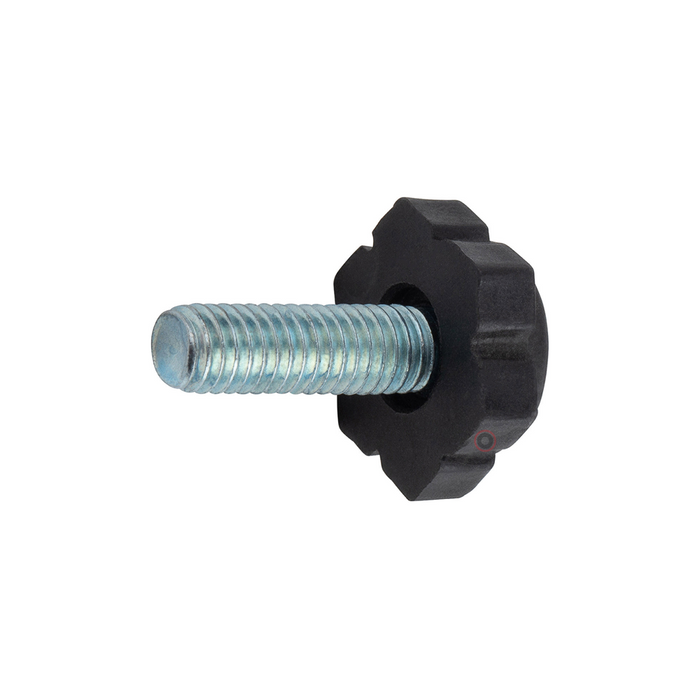Furniture Glide - Small Hex Shape.
Brands you know and trust - Maumac
Furniture Glide - Small Hex Shape.
This hex shape furniture glide has a base diameter of 17 mm with a M6 thread and a round dish shape base which makes it ideal on carpeted floors. Furniture glides work as two piece combo with tube threaded inserts. Check out the blog - Adjustable Levelling Feet Simplified.
Furniture Glide Key Features.
- Furniture glide, plastic nylon base with steel metric thread.
- Ideal for small items like tables, furniture, shelving, etc.
Maumac® Components is part of Aerobolt's furniture hardware range.
Levelling feet are used to provide a level, stable base for machinery or equipment, one that limits tipping, vibration, and noise. They have 101 uses from stabilising mighty CNC machines to fixing the wobbly kitchen table, an essential item because most floors are not truly level. They work by simply being a threaded shaft (stud) with a perpendicular base that acts like a foot, the stud bolts into a threaded tube insert and can be lengthened or shortened independently of each other until the item they are attached to is level. Turning the leveling foot clockwise shortens it, whilst turning it counterclockwise lengthens it. This is how levelling feet work. Adjustable feet are a useful component with endless different style and size options to select depending on your application from the all steel Titan Series through to the popular steel & plastic Dome Range. Also known as adjustable furniture feet, adjustable table feet, adjustable glides or leveling pads; they are a handy item that makes life a little easier by letting you control the height of objects on uneven floors, whilst ensuring the item is off the floor.
How do you measure adjustable levelling feet?
Outlined below are the important parts to consider when measuring your adjustable furniture or table feet.
1. Base Diameter: The Base Diameter is essential for stabilising and supporting the weight of the object. The larger the base, the better the level of stabilisation. To find the base diameter of the foot, you should measure the size across the base as labelled in the diagram.
2. Thread Length: Thread Length is important for the height adjustment and installation of feet. A longer thread will provide more upwards height than a shorter one. The thread length of an adjustable foot is often the distance between the stud and bolt. The stud is the part labelled "thread size". The bolt is the section where the thread joins the base.

3. Thread Size: Thread size is a key factor for supporting the weight of an object. It is also important for thread compatibility, as the thread must match the type that it is being screwed into. To find the metric thread size of a foot, you should start by measuring the diameter across the thread. This can be done by putting the ruler against the stud of the adjustable foot and taking the measurement in millimeters.
Weight Lab
The most important consideration is the base size and material. The base of the leveling mount can be plastic for lighter loads, or metal such as steel, zinc, or stainless steel for medium to heavy loads. Thread diameter and length can also provide a guide with the small diameters like the M4 or M5 for lighter loads whilst the M8 or M10 for heavier load. Other factors influencing the load capacity include: the distance from base of the foot and the amount of levelling feet used. The broad truss may suit larger furniture items whilst the Carona is more suitable for lighter items like small bathroom vanities. See the table below for a rough guide on load capacities.
| Base Diameter (mm) | Thread | Weight (kg) |
| 30 | M8 | 400 |
| 30 | M10 | 500 |
| 38 | M8 | 400 |
| 38 | M10 | 550 |
| 38 | M12 | 600 |
| 48 | M8 | 400 |
| 48 | M10 | 550 |
| 48 | M12 | 600 |
| 58 | M10 | 500 |
| 58 | M12 | 600 |
Note that the above table is a general guide only and that specific testing for your application is recommended. Other considerations include swiveling or stationary base and vibration resistance. Our range is predominately stationary however should your application require a swivel or a vibration-resistant option, please contact us.
Levelling feet are used to provide a level, stable base for machinery or equipment, one that limits tipping, vibration, and noise. They have 101 uses from stabilising mighty CNC machines to fixing the wobbly kitchen table, an essential item because most floors are not truly level. They work by simply being a threaded shaft (stud) with a perpendicular base that acts like a foot, the stud bolts into a threaded tube insert and can be lengthened or shortened independently of each other until the item they are attached to is level. Turning the leveling foot clockwise shortens it, whilst turning it counterclockwise lengthens it. This is how levelling feet work. Adjustable feet are a useful component with endless different style and size options to select depending on your application from the all steel Titan Series through to the popular steel & plastic Dome Range. Also known as adjustable furniture feet, adjustable table feet, adjustable glides or leveling pads; they are a handy item that makes life a little easier by letting you control the height of objects on uneven floors, whilst ensuring the item is off the floor.
How do you measure adjustable levelling feet?
Outlined below are the important parts to consider when measuring your adjustable furniture or table feet.
1. Base Diameter: The Base Diameter is essential for stabilising and supporting the weight of the object. The larger the base, the better the level of stabilisation. To find the base diameter of the foot, you should measure the size across the base as labelled in the diagram.
2. Thread Length: Thread Length is important for the height adjustment and installation of feet. A longer thread will provide more upwards height than a shorter one. The thread length of an adjustable foot is often the distance between the stud and bolt. The stud is the part labelled "thread size". The bolt is the section where the thread joins the base.

3. Thread Size: Thread size is a key factor for supporting the weight of an object. It is also important for thread compatibility, as the thread must match the type that it is being screwed into. To find the metric thread size of a foot, you should start by measuring the diameter across the thread. This can be done by putting the ruler against the stud of the adjustable foot and taking the measurement in millimeters.
Weight Lab
The most important consideration is the base size and material. The base of the leveling mount can be plastic for lighter loads, or metal such as steel, zinc, or stainless steel for medium to heavy loads. Thread diameter and length can also provide a guide with the small diameters like the M4 or M5 for lighter loads whilst the M8 or M10 for heavier load. Other factors influencing the load capacity include: the distance from base of the foot and the amount of levelling feet used. The broad truss may suit larger furniture items whilst the Carona is more suitable for lighter items like small bathroom vanities. See the table below for a rough guide on load capacities.
| Base Diameter (mm) | Thread | Weight (kg) |
| 30 | M8 | 400 |
| 30 | M10 | 500 |
| 38 | M8 | 400 |
| 38 | M10 | 550 |
| 38 | M12 | 600 |
| 48 | M8 | 400 |
| 48 | M10 | 550 |
| 48 | M12 | 600 |
| 58 | M10 | 500 |
| 58 | M12 | 600 |
Note that the above table is a general guide only and that specific testing for your application is recommended. Other considerations include swiveling or stationary base and vibration resistance. Our range is predominately stationary however should your application require a swivel or a vibration-resistant option, please contact us.





